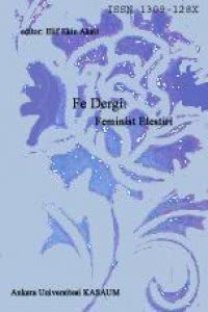Hipokratik Metinlerde Kadınların Doğası ve Jinekolojinin Ortaya Çıkışı
Genelde erkeklerin daha görünür olduğu eskiçağ yazının aksine, Hipokrates’in kadınları da görünür
kılan metodu, gözlem, yeni bir gözlem nesnesi yaratarak, jinekolojiyi doğurmuştur. Böylece antikitenin
“beyaz-kollu” kadını artık görünürün alanına getirilmiş olur. Hipokratik metinlerdeki kadın hasta
hikayelerinde, gözleme dayalı Hipokratik iş yapma biçiminin temelde iki kaynak ışığında çalıştığı
söylenebilir: her ikisi de, analitik ve analojik olanı bütünleştiren şekilde, genelde sağaltmaya doğru aktif
bir güç olan doğa, ve bedeni oluşturan dört temel sıvıdan (suyuk) biri olan su. Doğa’nın Hipokratik
pratikte bu kullanılış biçimi ekolojik bir bakış açısıyla Kuhn’un “karşılaştırılamazlık” kategorisine
karşı, bir arada iş yapma biçimlerini mümkün kılar. Çalışmada kısaca bilimsel (d)evrimlerin yapısı
incelenmeye Popper ile başlanmış, Kuhn, Lakatos, Feyerabend, ve son olarak Crombie ile devam edilip,
sonuncunun ‘düşünme biçimleri’ kavramının, pratiğe odaklanması ile, Hipokratik jinekolojik metodu
anlamakta kullanılabileceği vurgulanmıştır.
Anahtar Kelimeler:
düşünme biçimleri, kadın çalışmaları
___
- Crombie, A.C. (1994). Styles of scientific thinking in the European tradition: The history of argument and explanation
- especially in the mathematical and biomedical sciences and arts. London, UK: Duckworth Publications.
- Dean-Jones, L. (1994). Women's bodies in classical Greek science. Oxford, NY: Oxford University Press.
- Dumont, M. (1992). La gynécologie et l’obstétrique chez les Romains. Rev. For Gynécol. Obstét., 87, 10, 493-505.
- Feyerabend, P. (1975). Against method: Outline of an anarchist theory of knowledge. Humanities Press (First edition in M. Radner & S. Winokur, eds., Analyses of Theories and Methods of Physics and Psychology, Minneapolis: University of Minnesota Press, 1970).
- Grensemann, H. (1975). Knidische medizin teil I: Die testimonien zur ¨altesten knidischen lehre und analysen knidischer schriften im Corpus Hippocraticum. Berlin and NewYork: De Gruyter.
- Hanson, A. E. (1975). Hippocrates: “Diseases of women 1”. Signs, vol. 1, no. 2, pp. 567-584.
- Hanson, A. E. (1990). The medical writer’ women. In Halperin, D. M., Winkler, J. J., Zeitlin, F. I., (eds.) Before sexuality: the construction of erotic experience in the ancient Greek world, Princeton NJ: Princeton University Press.
- Herodotus (1988). The History. David Grene (tr), Chicago USA: University of Chicago Press.
- Holmes, B. (2010). The symptom and the subject: the emergence of the physical body in ancient Greece. Princeton, NJ: Princeton University Press.
- Jones, W. H. S. (1923a). Hippocrates. Volume I: Ancient Medicine Loeb Classical Library, No. 147.
- Jones, W. H. S. (1923b). Hippocrates. Volume II: Prognostic Loeb Classical Library, No.148
- Jones, W. H. S. (1931). Hippocrates. Volume IV: Nature of Man Loeb Classical Library, No. 150.
- Jouanna, J. (1999). Hippocrates. London, UK: John Hopkins University Press.
- King, H. (1998). Hippocrates' woman: reading the female body in ancient Greece. London and New York: Routledge.
- Koziak, B. (1999). Homeric thumos: The early invention of gender, emotion and politics. The Journal of Politics, vol. 61, no. 4, pp. 1068-91.
- Kuhn, T. (1962), The structure of scientific revolutions. Chicago, USA: University of Chicago Press.
- Lakatos, I. and Musgrave, A. (1970). Criticism and Growth of Knowledge. Cambridge, USA: Cambridge University Press.
- Lakatos, I. (1978). The Methodology of Scientific Research Programmes: Philosophical Papers Volume 1. Cambridge: Cambridge University Press.
- Longrigg, J. (1993). Greek rational medicine: philosophy and medicine from Alcmaeon to the Alexandrian times. UK: Routledge.
- Longrigg, J. (1998). Greek medicine: From the heroic to the Hellenistic age a source book. UK: Routledge.
- Potter, P. (2010). Hippocrates, Volume: IX. Loeb Classical Library, Harvard University Press.
- Smith, W. (1979). The Hippocratic tradition. Ithaca, NY: Cornell University Press.
- Smith, W. (1994). Hippocrates. Volume VII: Ancient Medicine Loeb Classical Library, No. 477.
- ISSN: 1309-128X
- Yayın Aralığı: Yılda 2 Sayı
- Başlangıç: 2008
- Yayıncı: Ankara Üniversitesi KASAUM
Sayıdaki Diğer Makaleler
Kadın Düşmanlığı Ölçeğinin Türkçe Formunun Geçerlik ve Güvenirlik Çalışması
VEYSİ BAYDAR, Cengiz KILIÇ, AYŞE SEZEN SERPEN, GÜLAY GÜNAY
Hipokratik Metinlerde Kadınların Doğası ve Jinekolojinin Ortaya Çıkışı
Yarı-Kamusal Alanda Kadın Deneyimlerine Etnografik Bakış
